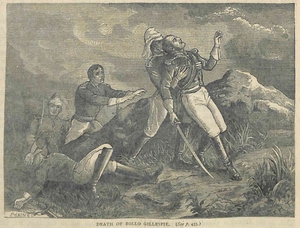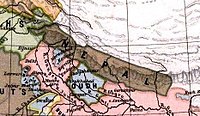
Back الحرب الإنجليزية النيبالية Arabic गोरखा युद्ध AWA Англо-непалска война Bulgarian एंग्लो-नेपाल जुद्ध (1814–16) Bihari ইংরেজ-নেপাল যুদ্ধ Bengali/Bangla Guerra Anglonepalesa Catalan Anglo-gurkhská válka Czech Gurkha-Krieg German Briti-Nepali sõda Estonian Gurkhasota Finnish
This article needs additional citations for verification. (November 2019) |
| Anglo-Nepalese War | |||||||||
|---|---|---|---|---|---|---|---|---|---|
 The death of Rollo Gillespie at the Battle of Nalapani | |||||||||
| |||||||||
| Belligerents | |||||||||
|
|
| ||||||||
| Commanders and leaders | |||||||||
| Strength | |||||||||
| a little more than 11,000[6] | |||||||||
| Casualties and losses | |||||||||
| Unknown | Unknown | ||||||||
| History of Nepal |
|---|
 |
|
|
The Anglo-Nepalese War (1 November 1814 – 4 March 1816), also known as the Gorkha War, was fought between the Gorkhali army of the Kingdom of Nepal (present-day Nepal) and the forces of the British East India Company (EIC). Both sides had ambitious expansion plans for the mountainous north of the Indian subcontinent. The war ended with a British victory and the signing of the Treaty of Sugauli in 1816, which ceded some of the Nepalese-controlled territory to the EIC. The British war effort was led by the EIC against the Kingdom of Gorkha. Most of the Kingdom of Gorkha's war effort was led by the two Thapa families: the Thapa dynasty and the family of Amar Singh Thapa.[note 2]
Cite error: There are <ref group=note> tags on this page, but the references will not show without a {{reflist|group=note}} template (see the help page).
- ^ "Britisch-Nepalischer Krieg 1814-1816". www.bilder-aus-nepal.de.
- ^ Pradhan 2012, p. 50.
- ^ Historical Dictionary of the British Empire: A-J, Volume 1; Volume 6, pp. 493
- ^ The Victorians at war, pp.155
- ^ Naravane (2006), p. 189
- ^ Smith 1852, p. 218
- ^ Prinsep 1825, p. 115.
- ^ "History of the Nepalese Army". nepalarmy.mil.np. Nepal Army. Archived from the original on 28 December 2017. Retrieved 16 January 2019.
- ^ Pradhan 2012, p. 26.
- ^ Anon 1816, p. 427.
- ^ Acharya 1971, p. 3.
- ^ Prinsep 1825, p. 93.